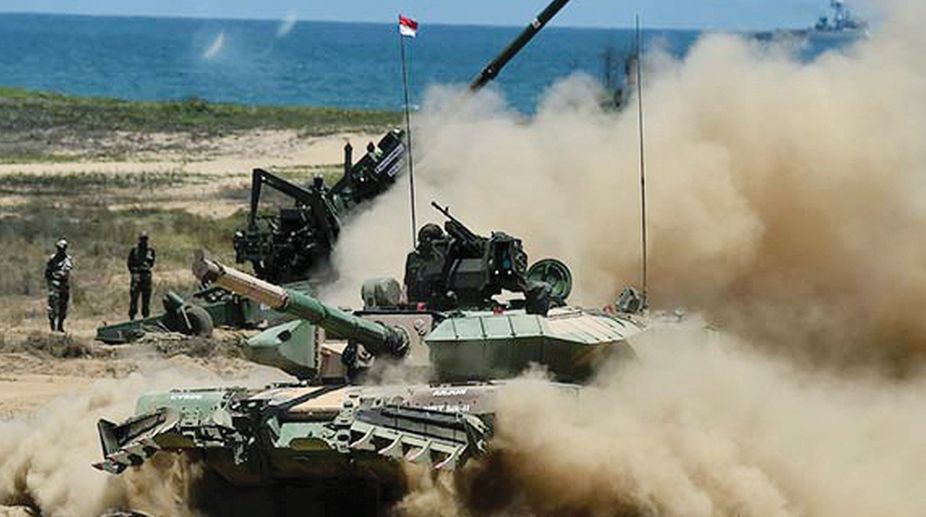India has the second-largest army, the fourth largest air force and the seventh-largest navy in the world. And it has the largest paramilitary in the world. It faces terrorism, both cross border and internal and hostile neighbours on both sides of the border, one of whom is a superpower. In such circumstances, it needs an up to date military-industrial complex and a robust Research & Development set up in order to meet the needs of its Armed Forces.
However, in what shows the pathetic state of Indian defence manufacturing, India imports 70% of its weapons requirements.
Recently, Union Defence Minister urged the DRDO officials to make India a global leader in the defence sector. He said, “We will have to focus on research work to emerge as the global leader in defence technologies. And for this, it is important to improve continuously in order to maintain operational superiority.” The Defence Minister added, “It is also the right time to decrease our dependence on imported systems and create an indigenous innovation ecosystem, to be completely self-reliant in the field of critical technologies.”
While the Modi government is looking towards a major leap in defence manufacturing and Research & Development, it seems that achieving these goals in the present defence manufacturing set up remains a far cry. India opened up defence manufacturing for the private sector in January 2002. However, India’s defence production remains almost entirely state-controlled.
R&D is done by DRDO (Defence Research and Development Organisation), while the manufacturing is done by nine defence PSUs (public sector undertakings) and the OFB (Ordnance Factory Board) which operates 41 ordnance factories in various parts of the country.
The private sector continues to be ignored in the larger defence production strategy. According to Indian Defence Review, decisions are said to be taken by the Defence Acquisition Council for categorising a proposal as ‘Buy’ or ‘Buy and Make’ or ‘Make’ on the basis of consultation with the DRDO and the public sector. The private sector is not given adequate attention, nor is it made a part of the consultation process. The private sector in defence production has also not been able to take off in a big way because the requirements of the Armed Forces are not made known to the private players well in advance, which would enable them to make necessary arrangements for the production of defence equipment. The private firms, therefore, do not get adequate time to look for foreign collaboration or to establish the necessary facilities for manufacturing.
The present defence manufacturing model, dominated by the public sector has not been able to fulfil the needs of world-class defence production and R&D. This explains the difference between India and advanced countries in the defence sector. The public sector has not been able to deliver the goods when it comes to defence production and R&D. The DRDO, the premier R&D organisation of India, itself has much to answer for. The DRDO has been pushing deadlines for all projects ranging from rifles to aircraft. The immediate consequence is that India’s public sector-dominated defence manufacturing industry has been failed to develop a single rifle, let alone a tank or an aircraft engine.
The Defence Public Sector Undertakings (DPSUs) have also proved largely incompetent and below par in terms of performance. Take the case of HAL, for example, which has been criticised for taking an incredibly long time in manufacturing. Moreover, production at a higher cost only leads to an unnecessary escalation in costs. Apart from this, the recent HAL strike makes it clear that DPSUs are also susceptible to strikes which adversely affects defence production capabilities.
As of now, the private sector is involved only at a low scale and is engaged in subsystems production. However, if India wants to fulfil its own weapons requirements and also realise its ambitions of accelerating defence exports, then it must make a major policy shift. It is time that the private sector is incentivised and its energies are harnessed in Defence R&D as well. The DRDO has proved inadequate, and the monopoly of the organisation on defence R & D seems rather unreasonable and unsustainable. A research paper published in the US-based Brookings instution has called for necessary changes in the DPP to bring about a level playing field for the public and private sectors in India. The paper suggests that this will accelerate the process of indigenisation by increasing competition. It is difficult to disagree with this observation.
It must be noted that the defence PSUs have come to dominate defence manufacturing. However, they have not helped India realise its goals. In 1995, India had set a target of becoming largely self-reliant in weapons requirements, by increasing India’s self-reliance index to 70 per cent. However, India continues to import around 70 per cent of its defence equipment. Now, the government has shifted this goal by over two decades to 2027. The public sector dominated defence manufacturing model has thus failed India. Primacy to DPSUs and monopoly of DRDO in defence R&D, has not yielded positive results for India. Now, the Modi government must make this major policy change towards greater involvement of the private sector, so that defence manufacturing and R&D take a much-needed leap.
